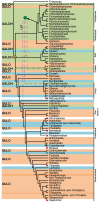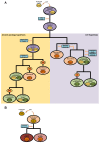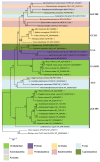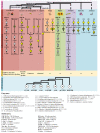Advances in Novel Animal Vitamin C Biosynthesis Pathways and the Role of Prokaryote-Based Inferences to Understand Their Origin
- PMID: 36292802
- PMCID: PMC9602106
- DOI: 10.3390/genes13101917
Advances in Novel Animal Vitamin C Biosynthesis Pathways and the Role of Prokaryote-Based Inferences to Understand Their Origin
Abstract
Vitamin C (VC) is an essential nutrient required for the optimal function and development of many organisms. VC has been studied for many decades, and still today, the characterization of its functions is a dynamic scientific field, mainly because of its commercial and therapeutic applications. In this review, we discuss, in a comparative way, the increasing evidence for alternative VC synthesis pathways in insects and nematodes, and the potential of myo-inositol as a possible substrate for this metabolic process in metazoans. Methodological approaches that may be useful for the future characterization of the VC synthesis pathways of Caenorhabditis elegans and Drosophila melanogaster are here discussed. We also summarize the current distribution of the eukaryote aldonolactone oxidoreductases gene lineages, while highlighting the added value of studies on prokaryote species that are likely able to synthesize VC for both the characterization of novel VC synthesis pathways and inferences on the complex evolutionary history of such pathways. Such work may help improve the industrial production of VC.
Keywords: aldonolactone oxidoreductases; ascorbic acid; evolution; insects; nematodes; prokaryotes; synthesis.
Conflict of interest statement
The authors declare no conflict of interest.
Figures






Similar articles
-
The evolution of vitamin C biosynthesis and transport in animals.BMC Ecol Evol. 2022 Jun 25;22(1):84. doi: 10.1186/s12862-022-02040-7. BMC Ecol Evol. 2022. PMID: 35752765 Free PMC article.
-
An overview of the insulin signaling pathway in model organisms Drosophila melanogaster and Caenorhabditis elegans.Peptides. 2021 Nov;145:170640. doi: 10.1016/j.peptides.2021.170640. Epub 2021 Aug 24. Peptides. 2021. PMID: 34450203 Review.
-
Comparative analysis of function and interaction of transcription factors in nematodes: extensive conservation of orthology coupled to rapid sequence evolution.BMC Genomics. 2008 Aug 27;9:399. doi: 10.1186/1471-2164-9-399. BMC Genomics. 2008. PMID: 18752680 Free PMC article.
-
Structure, mechanism, and evolution of the last step in vitamin C biosynthesis.Nat Commun. 2024 May 16;15(1):4158. doi: 10.1038/s41467-024-48410-1. Nat Commun. 2024. PMID: 38755143 Free PMC article.
-
Functions, applications and production of 2-O-D-glucopyranosyl-L-ascorbic acid.Appl Microbiol Biotechnol. 2012 Jul;95(2):313-20. doi: 10.1007/s00253-012-4150-9. Epub 2012 May 26. Appl Microbiol Biotechnol. 2012. PMID: 22639144 Review.
Cited by
-
Dual sources of melatonin and evidence for different primary functions.Front Endocrinol (Lausanne). 2024 May 14;15:1414463. doi: 10.3389/fendo.2024.1414463. eCollection 2024. Front Endocrinol (Lausanne). 2024. PMID: 38808108 Free PMC article. Review.
-
A Review on the Interaction of Acetic Acid Bacteria and Microbes in Food Fermentation: A Microbial Ecology Perspective.Foods. 2024 Aug 14;13(16):2534. doi: 10.3390/foods13162534. Foods. 2024. PMID: 39200461 Free PMC article. Review.
-
The perils of planning strategies to increase vitamin C content in plants: Beyond the hype.Front Plant Sci. 2022 Dec 19;13:1096549. doi: 10.3389/fpls.2022.1096549. eCollection 2022. Front Plant Sci. 2022. PMID: 36600921 Free PMC article. Review.
-
Comparative Analysis of Different Proteins and Metabolites in the Liver and Ovary of Local Breeds of Chicken and Commercial Chickens in the Later Laying Period.Int J Mol Sci. 2023 Sep 21;24(18):14394. doi: 10.3390/ijms241814394. Int J Mol Sci. 2023. PMID: 37762699 Free PMC article.
-
Vitamin C: From Self-Sufficiency to Dietary Dependence in the Framework of Its Biological Functions and Medical Implications.Life (Basel). 2025 Feb 5;15(2):238. doi: 10.3390/life15020238. Life (Basel). 2025. PMID: 40003647 Free PMC article. Review.
References
-
- Bauernfeind J.C. Ascorbic Acid: Chemistry, Metabolism, and Uses. American Chemical Society; Washington, DC, USA: 1982. Ascorbic Acid Technology in Agricultural, Pharmaceutical, Food, and Industrial Applications; pp. 395–497. Advances in Chemistry.
Publication types
MeSH terms
Substances
LinkOut - more resources
Full Text Sources
Medical
Molecular Biology Databases
Research Materials

